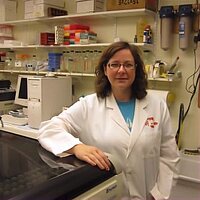Bioavailability of Dissolved and Colloidal Organic Carbon Bound Estrogen

Katrin Chambers is pursuing a M.S. degree in Soil Science. She graduated from Bemidji State University in Minnesota with B.S. Degrees in Biology and Chemistry. Prior to starting her graduate study she worked as a Quality Control Microbiologist at Solvay Pharmaceutical in Baudette, Minnesota. She was also contracted with the US EPA as an Aquatic Biologist in Duluth. Katrin's present research focuses on developing a means to quantify estrogenic potency of estrogen bound to dissolved and colloidal organic carbon, and also field evaluation of this method.
Email: katrin.chambers@ndsu.edu
Fellow: Katrin Bella Chambers
Advisor: Frank Casey, Ph.D., Professor, Soil Science
Degree Progress: M.S. in Soil Science expected graduation in Fall 2012.
Bioavailability of Dissolved and Colloidal Organic Carbon Bound Estrogen
The natural estrogen, 17ß-Estradiol (E2), is the most potent endocrine disrupting compound, where part per trillion concentrations can induce reproductive abnormalities in sensitive organisms. Estradiol is frequently detected in the environment at concentrations that could impact water quality. Estrogenic hormones will preferentially associate with dissolved (DOC) and colloidal (COC) organic carbon in soil and sediments, playing a significant role in the fate and transport of E2. Field studies have found significant correlations between estrogen detections and DOC and COC in soil leachate and river water. Although the association of E2 with DOC/COC can potentially facilitate its transport and persistence it is also important to identify whether the DOC/COC affects estrogen's toxicological effects.
The purpose of this study is to evaluate if E2 bound to DOC/COC is of concern to organisms in the environment. The bioavailability of estradiol bound to DOC/COC will be assessed using estrogen receptor competitive assays, which will be used as analogues to measure hormone receptor binding strength.
Project Objectives:
- Evaluate the association of radiolabeled estradiol with the both the DOC and COC fraction derived from liquid swine manure, soil and liquid swine manure applied to soil
- Simulate rainfall events to investigate the dislodgment of radiolabeled estradiol from the COC fraction
- Evaluate the estrogen potency of estradiol bound to the DOC/COC, DOC and COC fraction using estrogen receptor competitive assays.
Progress:
- E2 Association/Dissociation with COC: The results from the ultrafiltration of the swine lagoon manure spiked with radiolabeled E2 show that E2 is associated with COC partials and that E2 can be dislodged from the COC particles when rinsed with water. The environmental implication of these finding is that E2 can "hitch-hike" on COC partial to be distributed in the environment and be dislodged potentially as free estradiol.
- E2 Bound to COC is Characteristic of a Particulate: Reverse and normal phase Thin Layer Chromatography (TLC) has been done on the COC fraction of liquid swine manure. The result show that the radiolabelled E2 bound associated with the COC fraction does not behave like a molecule but more as a particle. Specifically, the COC fraction did not respond to chromatographic separation because the radioactivity stayed at the origin of both the normal and reverse phase TLC. This indicates that the 14C-E2 associated with the COC is acting like a particle and not like a molecule.
- E2 Bound to COC is Bioavailable: The results from the Estrogen Receptor (ER) competitive –binding assays show that there is an estrogen response induced by the E2 associated with the COC fraction. These result indicated that estradiol bound to COC still has endocrine disrupting properties and can potentially cause adverse effects to aquatic organisms. The estrogen response from the COC rinses mimics the response of the radiolabeled estradiol experiments. This indicates that estradiol can be carried by COC particles but is loosely bound and can be released into the environment as free estradiol.
Significance:
Estradiol is potent and detections are widespread in the environment. However, connections between toxicological significance and environmental detections of estrogens are largely unknown. To date, there is no real objective data that provides toxicological implications of hormone detections in the environment. Additionally, this research will be beneficial in the context of manure management, and its impacts on water quality.
Conference:
Casey, F.X.M., S. Shrestha, X. Bai, K. Chambers and H. Hakk. 2012. Role of Conjugates in the Fate and Transport of Steroid Hormones. In Annual Meetings Abstracts [CD-ROM]. ASA, CSSA, and SSSA, Madison, WI.
Chambers, K.B., F.X.M. Casey, H. Hakk, N.W. Shappell, T.M. DeSutter and E. Khan. 2011. Bioavailability of Colloidal Organic Carbon Bound Estrogen. In Annual Meetings Abstracts [CD-ROM]. ASA, CSSA, and SSSA, Madison, WI.
Chambers, Katrin. 2011. Bioavailability of Colloidal Organic Carbon Bound Estrogen. Organized oral session. ASA-CSSA-SSSA International Annual Meeting, San Antonio, TX

Frank Casey
Director of the School of Natural Resources
Office: Hultz Hall 202
Telephone: 701-231-8577
Email: francis.casey@ndsu.edu


